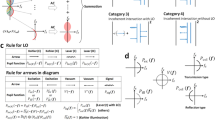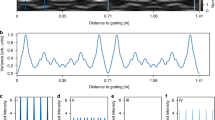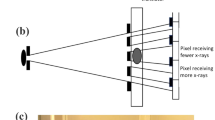Abstract
ROGERS'S1 elementary explanation of Gabor's2 technique for microscopy treats the hologram as a generalized Fresnel zone plate. I have used this idea for deriving a resolution criterion. Two point objects separated by a distance y produce two Fresnel zone patterns at the hologram with centres separated by a distance z, where z = pay/(Pa − qa), if Pa and qa are the distances from the illuminating point source of wave-length λa to the hologram film and from the film to the object, respectively. The subscript a refers to parameters of the ‘analysis’ while r will refer to the ‘reconstruction’.
This is a preview of subscription content, access via your institution
Access options
Subscribe to this journal
Receive 51 print issues and online access
$199.00 per year
only $3.90 per issue
Buy this article
- Purchase on Springer Link
- Instant access to full article PDF
Prices may be subject to local taxes which are calculated during checkout
Similar content being viewed by others
References
Rogers, G. L., Nature, 166, 237 (1950).
Gabor, D., Proc. Roy. Soc., A, 197, 454 (1949).
Myers, jun., Ora E., Amer. J. Phys., 19, 359 (1951).
Author information
Authors and Affiliations
Rights and permissions
About this article
Cite this article
BAEZ, A. Resolving Power in Diffraction Microscopy with Special Reference to X-Rays. Nature 169, 963–964 (1952). https://doi.org/10.1038/169963b0
Issue Date:
DOI: https://doi.org/10.1038/169963b0
This article is cited by
-
Albert Vinicio Baez and the promotion of science education in the developing world 1912–2007
PROSPECTS (2007)
-
The possibilities of neural holographic processes within the brain
Kybernetik (1970)
-
A New Method of Analysing Ionospheric Movement Records
Nature (1956)
-
Diffraction Microscopy with X-Rays
Nature (1952)
Comments
By submitting a comment you agree to abide by our Terms and Community Guidelines. If you find something abusive or that does not comply with our terms or guidelines please flag it as inappropriate.



